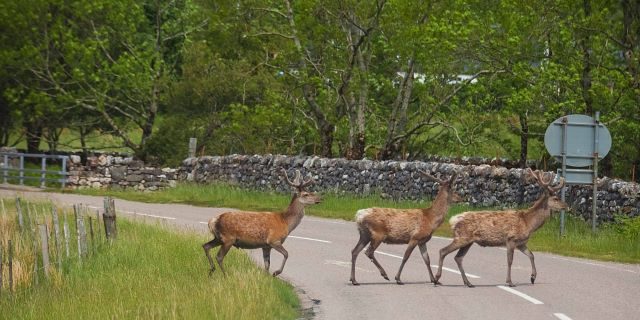The coming weeks will see a significant rise in the risk of collisions with deer and other wild animals, warns road safety organisation GEM Motoring Assist. This is the rutting season, which makes deer more likely to be on the roads.
Figures from the Deer Initiative indicate that between 42,000 and 74,000 deer are involved in collisions each year on roads in the UK. These events are thought to lead to more than 450 injuries, and up to 20 fatalities involving drivers and passengers each year. Industry estimates put the cost of damage to vehicles alone to be at least £11 million.
GEM chief executive Neil Worth says it’s at dawn and dusk when deer movements appear to peak. “We urge drivers to be on the look-out at all times, but to be particularly observant in the early mornings and early evenings,” he says. “And it’s important to expect deer not just on rural lanes, as figures show more than half of all deer strikes occur on motorways.”
“If you know your route takes you through areas where there are deer, then expect individual animals – or larger groups – to be crossing the road ahead of you. The warning signs are there for a reason, so make sure you give yourself time and space to stop if you do encounter deer crossing.”
These days, it’s not only deer drivers should be looking out for. In some regions, such as the Forest of Dean, collisions with wild boar exceed those involving deer.
Although wild boar became extinct in the UK around 400 years ago, they are now back in some parts of the country. The UK is home to an estimated wild boar population of 2,600 or more. Around 500 wild boar die in the Forest of Dean each year, either through culling by marksmen or because of a road collision.
Wild boar can reach 150kg in weight, meaning a collision could have severe consequences both for boar and vehicle. The animals can be seen in daylight hours, but they usually come out after dark, adding to the collision risk.
Although there is no legal requirement for a motorist to report a crash with a deer or wild boar, police urge drivers to report any crash where an animal is left on the road, purely because of the danger presented to other road users.
Wild animal collision advice
- First, take note of warning signs, as they have been placed at locations where wild animal crossings are common.
- If you have seen a deer going across the road, don’t speed up and assume the risk has passed. Chances are that there will be other deer close by, all likely to be crossing the same road.
- You will only have a short reaction time. But don’t swerve too hard to avoid hitting a wild animal. If a collision with the animal seems inevitable, then hit it while maintaining full control of your car. The alternative of swerving into oncoming traffic or a ditch could be even worse.
- If you hit and injure a deer, stop somewhere safe and report the collision to the police. If the deer remains on the road, you should dial 999 as there is an immediate risk of another collision. The police can also organise professional veterinary assistance.
- If you hit a wild boar and it remains on the road, call 999 so that police officers can come out and ensure the road is made safe. Officers can also liaise with the Forestry Commission, who would send a marksman if the need arose to put down a badly injured animal.
- From an insurance point of view, you should be able to make a claim for damage sustained in a collision with a wild animal but check the small print of your policy first. Bear in mind that in making a claim you would lose your no claims bonus.

